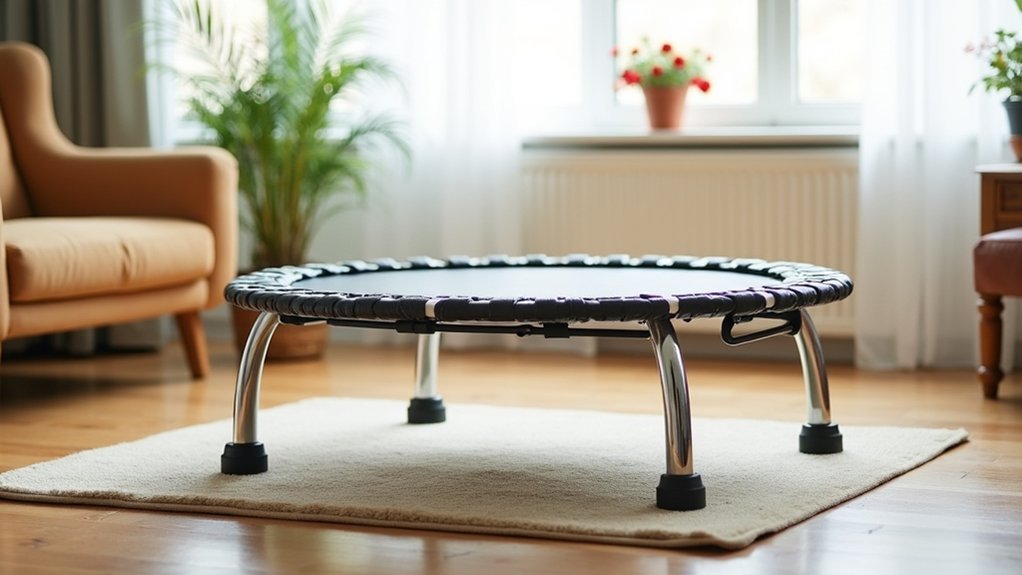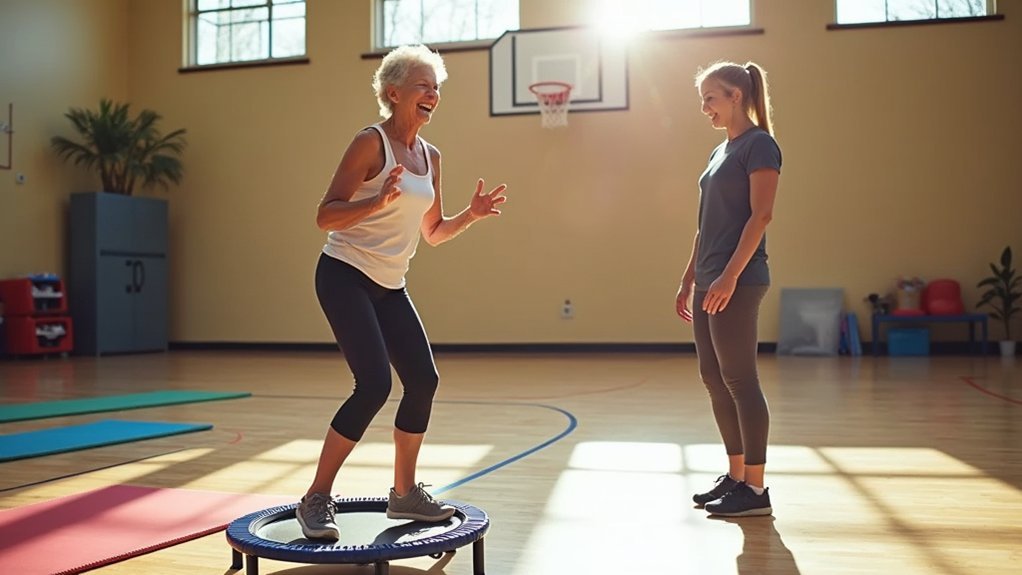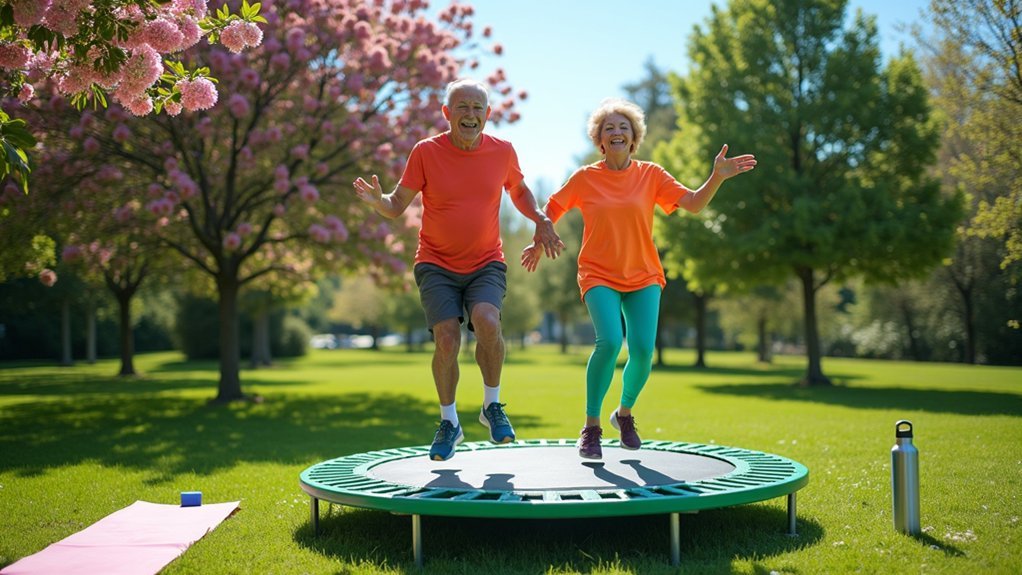For safe senior rebounding, always place your mini-trampoline on a flat surface and consider models with handrails for added security. Stand with feet shoulder-width apart and maintain proper posture, engaging your core while bouncing gently with slightly bent knees to absorb impact. Start with just 3-5 minutes daily of health bounces before gradually increasing duration as your balance improves. These simple precautions transform this low-impact exercise into a joint-friendly fitness option.
Setting Up Your Rebounder for Maximum Stability and Safety

Before you begin enjoying the benefits of rebounding, properly setting up your equipment creates a foundation for safe exercise.
Place your rebounder on a flat, stable surface away from furniture and secure it with anti-slip mats to prevent movement during use. Ascertain you have adequate overhead clearance and good lighting to avoid accidents.
For added security, consider models with handrails, especially beneficial for seniors needing extra support. This feature is crucial as it helps seniors maintain proper balance while performing exercises that enhance coordination.
Check that your exercise area has proper ventilation and is free from tripping hazards. Regularly inspect your rebounder’s legs and components for stability and wear.
Always follow the manufacturer’s assembly instructions carefully and verify the rebounder can support your weight.
When not in use, store it securely to prevent unauthorized access and potential accidents.
Proper Stance and Movement Techniques for Joint Protection
Mastering proper stance and movement techniques on your rebounder noticeably reduces joint strain while maximizing the exercise benefits for seniors. Stand with your feet slightly apart and parallel, distributing weight evenly while engaging your core muscles.
Always bounce with control, keeping movements smooth and gentle. Land softly by flexing your ankles and bending your knees slightly to absorb shock. Remember to keep bounces low—height isn’t necessary for effectiveness.
Bounce gently with purpose—your joints will thank you for landing soft and staying low.
Maintain proper body mechanics by stabilizing your core throughout each movement. Transfer your weight gradually and keep arm movements controlled. Taking regular brief rest periods helps prevent repetitive strain on already sensitive joints. If you experience any pain, stop immediately and rest.
Incorporate deep breathing as you bounce to enhance relaxation and oxygen flow. Listen to your body’s signals and adjust intensity accordingly.
Building an Age-Appropriate Rebounding Routine

How can seniors safely enjoy the remarkable benefits of rebounding while respecting their bodies’ unique needs?
Start with a 3-5 minute gentle warm-up using health bounces where your feet remain on the mat.
Structure your routine with 10-15 minutes of basic exercises like seated bounces if you have mobility concerns, or side-to-side movements to enhance balance. Studies show that just 14 weeks of consistent mini-trampoline exercises can improve your balance by 35 percent.
For stability, consider a rebounder with adjustable handlebars.
Aim for consistency with daily or near-daily sessions, but always listen to your body.
Track your progress in a simple exercise log to monitor improvements in strength and balance.
Remember to gradually increase intensity as you build confidence and strength.
Finish each session with gentle stretching to cool down and maintain flexibility.
Frequently Asked Questions
Can Rebounding Exercises Improve Bone Density in Seniors?
Rebounding exercises show mixed results for bone density in seniors. You’ll see modest improvements in femoral neck BMD, but limited spine benefits. They’re better for improving balance, reducing fall risk, and enhancing overall mobility.
How Do Medications Affect Safe Rebounding Practices?
Some medications can affect your balance, coordination, and energy levels when rebounding. You’ll need to time your exercise around medication effects and may require modified routines to maintain safety during your bouncing exercises.
What Clothing and Footwear Are Best for Senior Rebounding?
Wear lightweight, flexible shoes with non-slip treads for stability. Choose moisture-wicking, form-fitting clothes that won’t restrict movement. Don’t forget supportive undergarments and avoid loose clothing that could cause tripping hazards.
Can Rebounding Help With Balance Issues or Fall Prevention?
Yes, rebounding considerably improves your balance through stimulating proprioceptive and vestibular systems. You’ll develop better postural control and stronger leg muscles, which directly contributes to fall prevention, especially after consistent practice over 10-14 weeks.
How Does Rebounding Compare to Water Aerobics for Seniors?
Rebounding offers low-impact cardio with balance benefits you can do at home, while water aerobics provides zero-impact exercise in a social setting. Both strengthen muscles and improve mobility, but rebounding requires less access logistics.
In Summary
Rebounding offers a fantastic low-impact workout that you’ll enjoy well into your senior years. By properly setting up your equipment, maintaining correct form, and following an age-appropriate progression, you’re safeguarding your health while boosting your fitness. Listen to your body, don’t rush your progress, and you’ll reap the benefits of this gentle yet effective exercise. Happy bouncing—your joints will thank you!





Leave a Reply